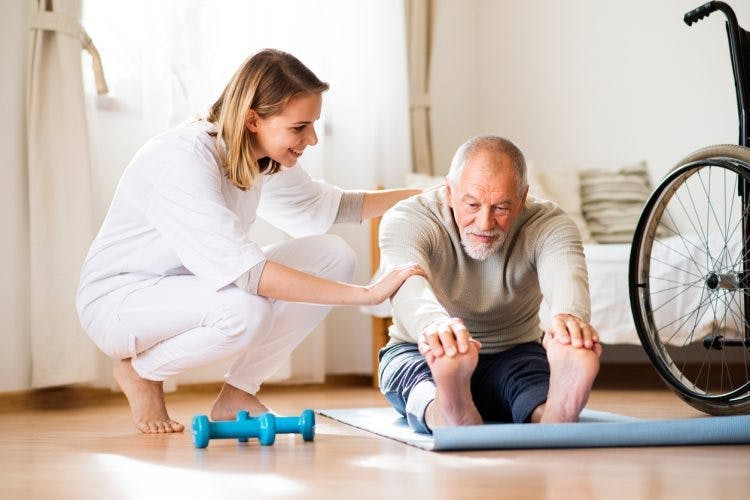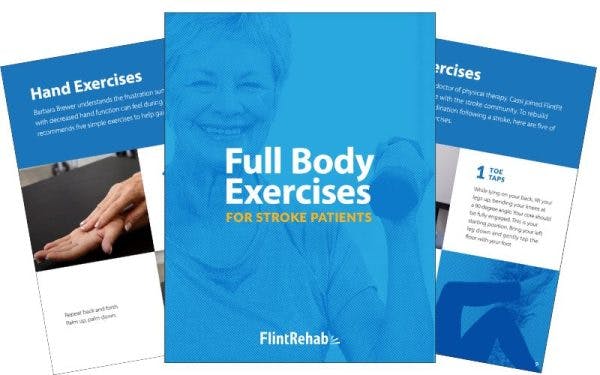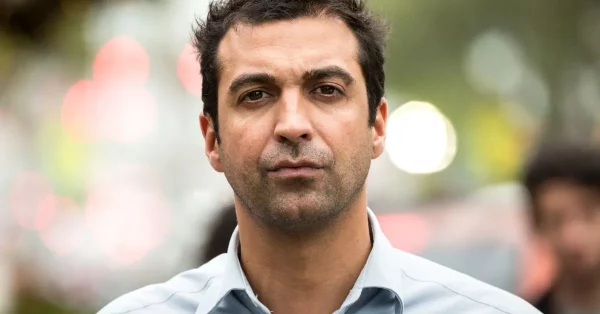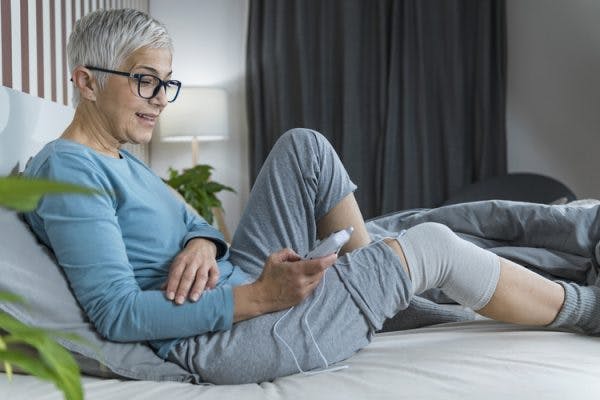Knowing the difference between active vs passive exercises can help you understand what your rehabilitation process will encompass. It can be difficult for survivors to pinpoint what types of exercise after stroke are best suited for their unique journey. However, this can be simplified by learning how stroke survivors can use the two main types of exercise, active and passive, to improve their health and function.
This article will review the difference between active vs passive exercises, who should use each type, and how they can benefit your rehabilitation program. To help navigate through this article, use the links below to jump straight to any section:
- What Are Passive Exercises?
- Who Can Benefit from Passive Exercises?
- What Are Active Exercises?
- Who Can Benefit from Active Exercises?
- Active and Passive Exercises to Get You Started
What Are Passive Exercises?
Passive exercises are performed without active muscle contraction, meaning you do not exert any effort with the limb being exercised or moved. You may sometimes hear these described as passive range of motion (ROM) exercises. These exercises help move your joint through the full range, or extent, of their motion in all available directions.
Passive exercises can be performed with assistance, such as from a therapist or caregiver, as they help move your muscles and joints through their full range of motion for you. Additionally, individuals can perform passive exercises independently by using an unaffected limb (such as the opposite arm or leg) to move the affected limb.
Who Can Benefit from Passive Exercises?
Passive range of motion exercises are great for stroke survivors with hemiplegia (paralysis on one side of the body) or hemiparesis (weakness on one side of the body). Additionally, passive exercise is an effective treatment for spasticity after stroke, which refers to tight, stiff muscles caused by neurological injury.
All survivors can benefit from passive exercise, especially in the early stages of stroke recovery when movement may be more limited. Passive range of motion exercise is a great way to perform early mobilization, which the American Heart Association recommends in the acute stages of stroke recovery.
Although passive exercise does not require active muscle contraction, the movement still carries many benefits. For instance, movement improves blood flow in the affected areas and provides sensory stimulation to the limb. Passive exercise also helps prevent spasticity from worsening and leading to other complications such as curled fingers after stroke.
Passive exercises provide the greatest benefits when they are used consistently over a long period. Consistent repetition of therapeutic movements helps spark neuroplasticity: the mechanism the brain uses to rewire itself. In fact, a recent study found that passive exercise offered the same benefits to brain health as active exercise!
However, for passive exercise to induce neuroplasticity, attention must be paid to the movement. Passive exercise won’t be as helpful if done while distracted or disengaged in the activity. Patients must focus on the passive exercises themselves to receive maximal benefits from them.
What Are Active Exercises?
While passive exercises are performed without voluntary muscle contraction, active exercises involve your physical effort exerted into muscular activity. These exercises can include active range of motion, like self-stretching, or general stroke rehabilitation exercises where you move your muscles through therapeutic movements for strengthening. Basically, when you’re doing the exercises yourself, it’s active exercise.
Movement difficulties occur after neurological injury because the brain cannot send the correct signals to the affected muscles. Depending on the area of the brain affected by stroke, survivors will experience different secondary effects or movement impairments.
While these secondary effects can alter many aspects of daily life for stroke survivors, there is always hope for recovery through the consistent practice of your rehabilitation program. This includes performing both active and passive exercises to help the brain heal and create new movement pathways.
Rehabilitation exercise encourages the brain to rewire itself through neuroplasticity, which improves its ability to send signals to your muscles. As we mentioned earlier in this article, neuroplasticity occurs with both passive and active exercises. One major difference, however, is that active exercise also helps with muscle strengthening.
Active exercise is particularly beneficial if muscle atrophy has occurred after stroke due to reduced daily movement. Increasing muscle strength after stroke is a necessary piece of the recovery puzzle and can help improve balance, performance of daily activities, walking (gait), and cardiovascular health. Additionally, increasing your strength can help improve safety by reducing fall risk after stroke.
Want 25 pages of stroke recovery exercises in a PDF? Click here to download our free Stroke Rehab Exercise ebook now (link opens a pop up for uninterrupted reading)
Who Can Benefit from Active Exercises?
Anyone who experiences muscle weakness after stroke can benefit from active exercise. As long as the survivor has some contraction of their muscles (even if the control is not substantial), active exercise can be utilized to make improvements in mobility, strength, and overall function.
Active exercise is often performed after passive exercise, especially when mobility is limited or restricted by conditions like spasticity. Passive exercise helps warm up the muscles and prepare them for active use (think of stretching before strengthening).
Patients who have some movement of their affected side and are working towards regaining more mobility can begin with active exercises. However, ask your physical therapist what’s right for you. Some range of motion exercises are recommended regardless of mobility level, and your therapist can help you create a plan that is best suited to your unique goals.
Keep in mind that there are always ways to make exercise possible following stroke. For example, those who have limited strength can perform active-assisted exercise. This is when an individual uses active muscle contraction to perform at least part of the active exercise, with assistance from an unaffected limb or therapy tool to complete the motion.
Just like passive exercise, active exercise benefits patients by stimulating neuroplasticity. Over time, consistent practice of active and passive exercise provides the brain with the stimulation it needs to rewire itself and regain functions that may have been lost due to stroke.
Active vs Passive Exercises to Get You Started
Now that you know the difference between active vs passive exercises, do you feel like your rehabilitation regimen is properly adapted to your ability level? If not, talk with your therapist about your concerns. Your therapist is a trained expert and can adjust your current exercises or recommend new ones to fit your needs.
Additionally, your therapist will help you create a home exercise program to allow you to continue working toward recovery at home. Healing involves the survivor taking charge of their exercises, as that is when the best results are achieved.
The key to making progress, even at home, is high repetition of therapy exercises (sometimes called massed practice). To assist with this, at-home rehab exercise devices like FitMi home therapy help motivate patients to exercise at home. This device is therapist-approved because it adapts to your ability level, and patients can practice both passive and active exercises.
Rehab devices have higher compliance rates than written sheets of exercise, which means that patients see better results with fun, interactive equipment. Ultimately, the best program for you is one that you can be consistent with and that helps you reach your own specific goals.
To help you get started toward recovery, here are some free exercise guides from our rehabilitation blog:
Passive Exercise Guides:
- Paralysis Recovery Exercises for Stroke Patients
- Passive Range of Motion Exercises for Stroke Patients
Active Exercise Guides:
- Full Body Exercises for Stroke Patients
- 9 Hand Exercises for Stroke Patients
- Leg Exercises for Stroke Patients
- Shoulder Exercises for Stroke Patient
Now that you understand the difference between active vs passive exercises, it is important to select exercises that are safe for your ability level but also challenge you to work hard. Practicing active and passive exercises consistently will allow you to see the best results over time. If you’re unsure what exercises are right for you, ask your therapist for recommendations that best suit your specific needs.









